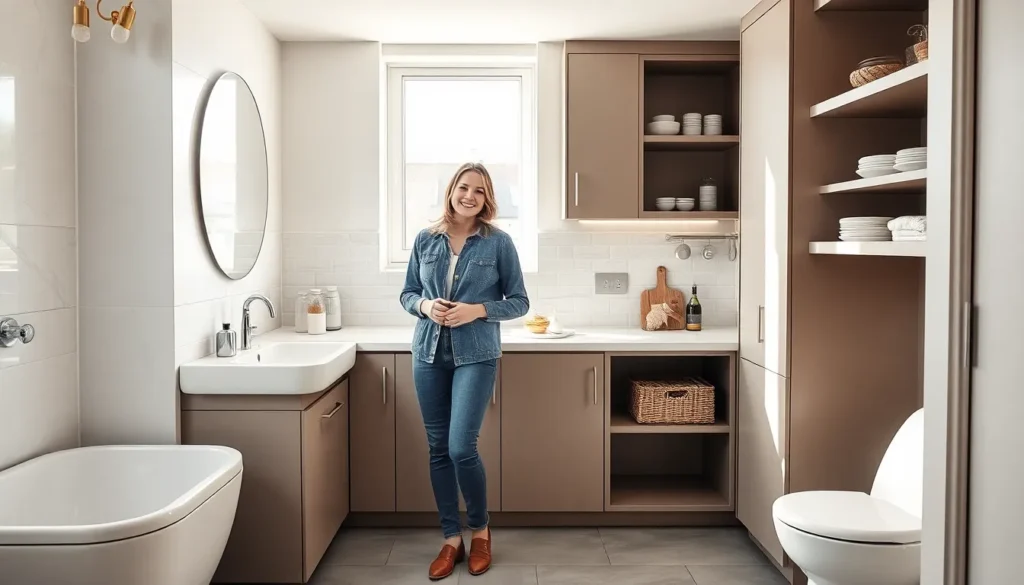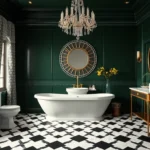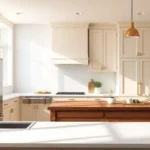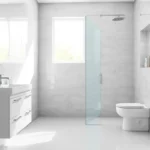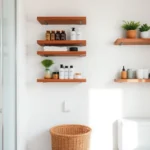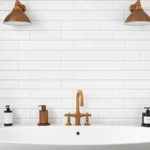When we think about maximizing space and functionality in our homes, we often overlook the incredible potential of combining bathroom and kitchen design elements. Whether you’re dealing with a studio apartment, tiny home, or simply want to create a more efficient living space, bathroom kitchen combos offer innovative answers that don’t compromise on style or comfort.
We’ve discovered that smart design choices can transform even the smallest areas into multi-functional spaces that work beautifully for daily living. From compact appliances that fit seamlessly alongside bathroom fixtures to creative storage answers that serve dual purposes, these hybrid spaces are revolutionizing how we think about home design.
The key lies in understanding how to blend aesthetics with practicality while maintaining proper ventilation, plumbing, and electrical systems. We’ll explore creative layouts, space-saving fixtures, and design tricks that make bathroom kitchen combinations both functional and visually appealing for modern homeowners.
Open Concept Bathroom Kitchen Combinations for Modern Living
Open concept bathroom kitchen combinations represent the pinnacle of space-efficient design for contemporary living. We’re seeing these innovative layouts revolutionize how homeowners approach multi-functional spaces.
Maximizing Space in Small Apartments
Vertical storage answers transform cramped quarters into functional powerhouses by utilizing every inch of wall space. We recommend installing floor-to-ceiling cabinets that serve dual purposes like housing toiletries above and kitchen essentials below. Corner units with rotating shelves provide 40% more storage capacity than traditional straight cabinets.
Multi-purpose fixtures eliminate the need for separate installations while maintaining full functionality. Vanity countertops extend seamlessly into breakfast bars, creating dining space that doubles as prep area. We’ve found that fold-down tables attached to walls save up to 8 square feet when not in use.
Sliding partitions offer flexibility without permanent walls that consume precious floor space. Glass panels on tracks move effortlessly to separate areas when needed while maintaining the open feel. These systems typically require only 2-3 inches of ceiling space for mounting hardware.
Creating Seamless Flow Between Areas
Consistent flooring materials unify bathroom kitchen combinations by creating visual continuity throughout the space. We suggest waterproof luxury vinyl planks or polished concrete that handle moisture while maintaining style. These materials cost 30% less than installing separate flooring types.
Coordinated color schemes prevent the space from feeling disjointed or chaotic during daily use. Neutral palettes with white, gray, and natural wood tones work exceptionally well for maintaining cohesion. We recommend limiting the color palette to three main hues for optimal visual harmony.
Strategic lighting placement guides the eye naturally from cooking areas to bathing zones. Recessed LED strips under cabinets provide task lighting while pendant fixtures define separate functional areas. Smart lighting systems allow different zones to operate independently while maintaining the overall ambiance.
Maintaining Privacy While Sharing Utilities
Smart partition systems provide privacy on demand without compromising the open concept design. Frosted glass panels, decorative screens, and curtain tracks offer flexible answers that adapt to different needs throughout the day. These installations typically cost between $200-800 depending on materials and complexity.
Zoned ventilation systems ensure proper air circulation while containing odors and humidity in their respective areas. We install separate exhaust fans rated at 110 CFM for bathrooms and range hoods with 400+ CFM capacity for kitchens. Independent controls prevent cross-contamination of air between zones.
Thoughtful fixture placement creates natural privacy barriers without feeling cramped or closed off. Positioning the toilet behind a half-wall or around a corner maintains intimacy while keeping plumbing lines accessible. Kitchen islands serve as visual dividers that provide counter space and storage simultaneously.
Shared Plumbing Solutions to Reduce Installation Costs
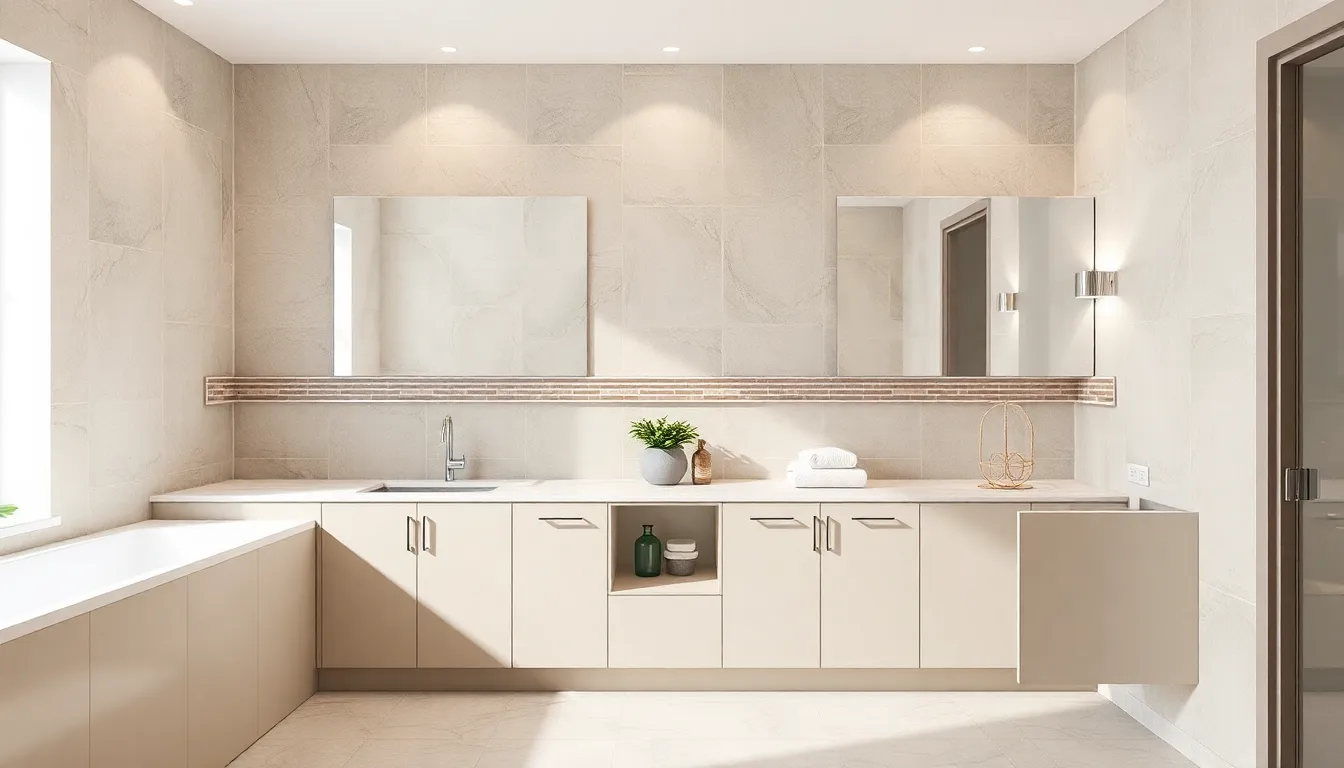
Strategic plumbing arrangements can dramatically reduce installation expenses while maintaining the functional elegance we’ve established in our bathroom kitchen combinations. We’ll explore cost-effective approaches that leverage shared water systems to maximize both efficiency and budget considerations.
Back-to-Back Layouts for Efficient Water Lines
Back-to-back positioning transforms how we approach fixture placement in combined bathroom kitchen spaces. Kitchen and bathroom sinks share water lines when positioned opposite each other in adjacent areas, eliminating the need for separate hot and cold water infrastructure. This configuration reduces plumbing materials by up to 40% compared to traditional separate-room installations.
We recommend placing your kitchen sink directly behind your bathroom vanity to capitalize on shared plumbing runs. Modern designs incorporate this layout seamlessly by using the shared wall as a feature element with coordinated tile or accent materials. Drain lines benefit equally from this proximity, requiring fewer connections and reducing potential leak points throughout the system.
Stacked Design Options for Multi-Story Homes
Stacked plumbing creates vertical efficiency in multi-level bathroom kitchen combinations by aligning fixtures floor to floor. Toilets positioned directly above or below each other simplify waste line routing and reduce the complexity of drain system installations. We’ve seen installation costs decrease by 25-35% when implementing strategic vertical alignment in townhouses and multi-story layouts.
Upper level bathroom fixtures connect seamlessly to lower level kitchen plumbing when we plan the vertical runs during initial design phases. Sinks stacked above kitchen prep areas create natural workflow patterns while sharing common supply lines. Water pressure remains consistent throughout stacked systems when we properly size the main supply lines to accommodate multiple fixture demands.
Central Utility Core Planning
Central utility cores concentrate major plumbing components into designated zones within our bathroom kitchen combinations. Water heaters positioned centrally between bathroom and kitchen areas reduce pipe runs by 50-60% compared to traditional corner installations. We group shut-off valves, main distribution manifolds, and filtration systems into accessible utility spaces that serve both functional areas efficiently.
Planning utility cores during the design phase allows us to minimize exposed plumbing while maintaining easy maintenance access. Modern utility cores incorporate sleek cabinet fronts that blend with our overall aesthetic while housing essential plumbing infrastructure. We position these cores strategically to serve as natural room dividers while providing the backbone for our shared plumbing systems.
Multi-Functional Storage Ideas for Dual-Purpose Spaces
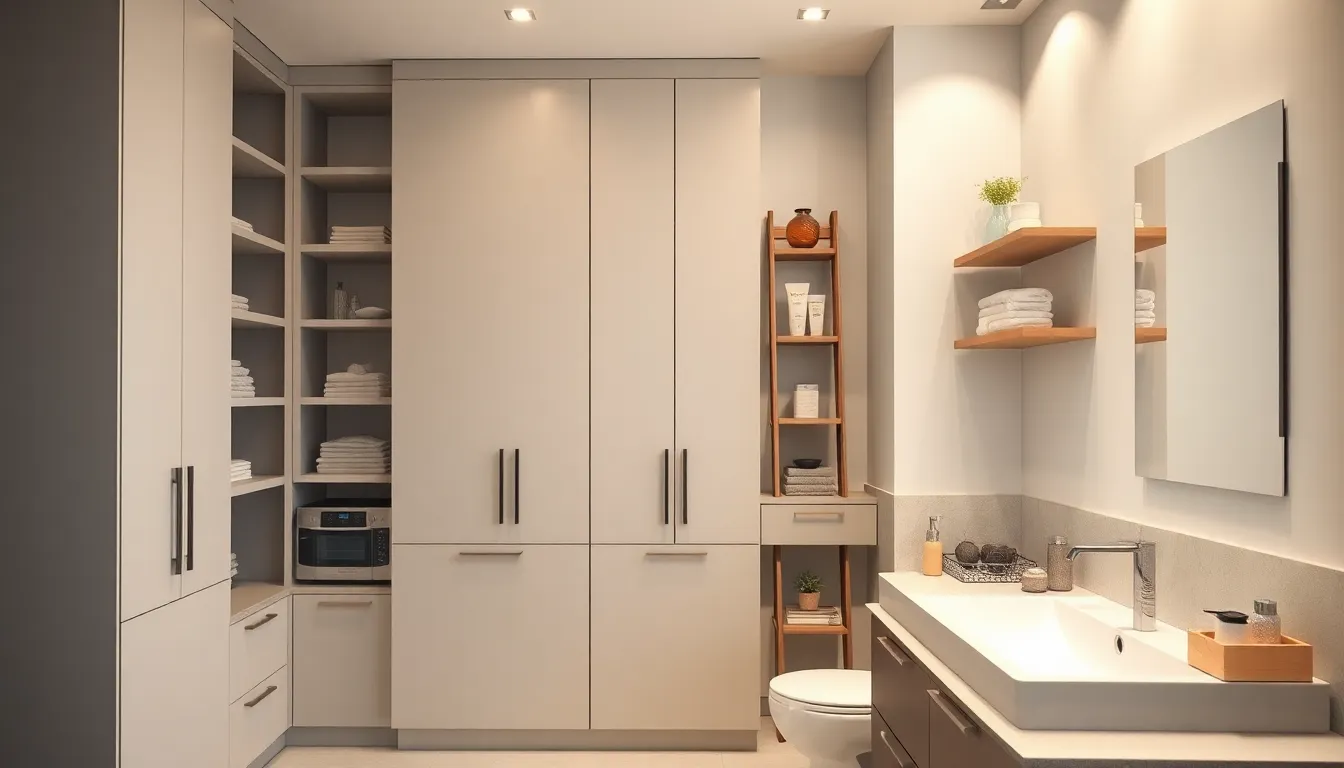
Smart storage answers transform combined bathroom kitchen spaces into highly functional areas that maximize every square inch. We’ll explore innovative approaches that keep both cooking and bathing essentials organized while maintaining the seamless flow these spaces require.
Built-In Cabinetry That Serves Both Rooms
Built-in cabinetry creates the foundation for efficient dual-purpose storage by seamlessly accommodating both kitchenware and toiletries in one unified system. Cabinets with adjustable shelving offer the flexibility we need to store everything from dinner plates to bath towels without compromising accessibility.
Customizable interiors with pull-out shelves make organizing these diverse items effortless while keeping everything within easy reach. Mirrored cabinet doors serve a dual function by providing essential bathroom mirrors while concealing storage compartments and reflecting light to brighten the entire space.
These built-in answers create visual continuity between the kitchen and bathroom zones while giving us the illusion of more space through strategic design choices. Adjustable shelving systems allow us to reconfigure storage as our needs change over time.
Hidden Storage Answers for Toiletries and Kitchen Items
Hidden storage maintains the clean aesthetic that dual-purpose spaces require while keeping frequently used items accessible. Under-sink pull-out baskets create concealed compartments that house both cleaning supplies and personal care products without cluttering countertops.
Multi-functional furniture pieces like storage benches or ottomans provide concealed compartments for items we don’t use daily. Wall niches carved into the space between studs offer discreet storage for smaller toiletries and spice jars while maintaining the room’s streamlined appearance.
These concealed answers keep our essentials out of sight but within easy reach when we need them. Over-the-door organizers maximize unused space behind doors for storing items like towels, cleaning supplies, and kitchen linens.
Vertical Storage Maximization Techniques
Vertical storage answers maximize our available space without sacrificing valuable floor area in compact dual-purpose rooms. Tall cabinets that reach from floor to ceiling provide ample storage for both kitchen pantry items and bathroom supplies while drawing the eye upward to create height illusion.
Ladder shelves offer stylish vertical storage that can display decorative items alongside functional necessities. Floating wall shelves provide flexible storage options that we can adjust or relocate as our needs evolve.
| Vertical Storage Type | Best For | Space Saved |
|---|---|---|
| Tall cabinets | Pantry goods, towels | 60-80% floor space |
| Ladder shelves | Display and storage | 50-70% floor space |
| Floating shelves | Light items, decor | 40-60% floor space |
Wall-mounted options like floating shelves keep countertops clear while providing easy access to frequently used items. Adjustable shelving systems allow us to customize storage heights for different items, from tall bottles to compact containers.
Coordinated Design Themes to Unify Your Spaces
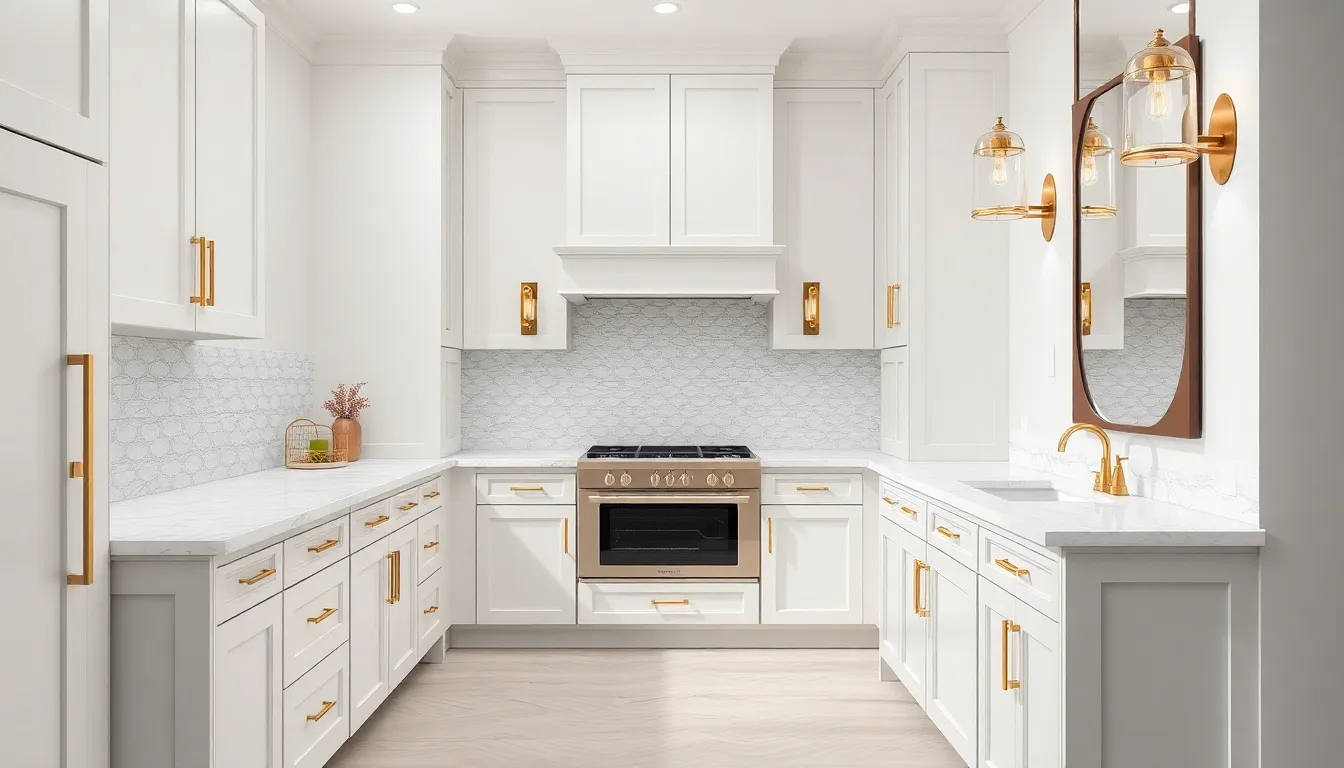
Creating visual harmony between bathroom and kitchen spaces transforms our homes into cohesive environments that feel intentionally designed.
Matching Color Palettes and Materials
Popular scheme choices from the National Kitchen & Bath Association (NKBA) include whites, grays, beiges, blues, blacks, and greens that offer flexibility and modern appeal. We can achieve remarkable continuity by selecting similar flooring materials throughout both spaces, whether that’s luxury vinyl planks, ceramic tiles, or natural stone. Cabinet finishes should complement each other without being identical—pairing white kitchen cabinets with light gray bathroom vanities creates subtle variation while maintaining unity.
Countertop materials provide another opportunity for coordination. Quartz surfaces work beautifully in both environments, offering durability and consistent veining patterns that tie the spaces together. Natural materials like marble or granite can bridge both rooms when we choose complementary slabs from the same stone family.
Consistent Hardware and Fixture Styles
Hardware selection plays a crucial role in unified design throughout our connected spaces. Common finishes like nickel, chrome, matte black, and brushed brass work effectively in both kitchens and bathrooms, providing visual continuity without appearing overly matched. Cabinet pulls should maintain similar proportions and styles—elongated bar pulls in the kitchen can pair with smaller versions on bathroom vanities.
Faucet designs deserve careful consideration for both function and aesthetics. Modern single-handle faucets with similar geometric lines create cohesion, while traditional styles with matching curves maintain classic appeal. Plumbing accessories like towel bars, soap dispensers, and cabinet knobs should echo the chosen finish family throughout both spaces.
Complementary Lighting Design Strategies
Layered lighting combining ambient, task, and accent options works best in both kitchens and bathrooms according to design best practices. We should use similar light fixture designs or finish options to ensure connected aesthetics while meeting each room’s unique intensity requirements. Pendant lights over kitchen islands can coordinate with vanity sconces through matching metal finishes or glass shapes.
Adjustable fixtures and dimmable options provide flexibility for different activities. Task lighting for food preparation mirrors the focused illumination needed for grooming tasks. Strategic placement creates natural flow between spaces—under cabinet lighting in kitchens can complement similar strips under bathroom vanities for consistent ambiance throughout our coordinated design.
Space-Saving Fixtures for Compact Bathroom Kitchen Areas
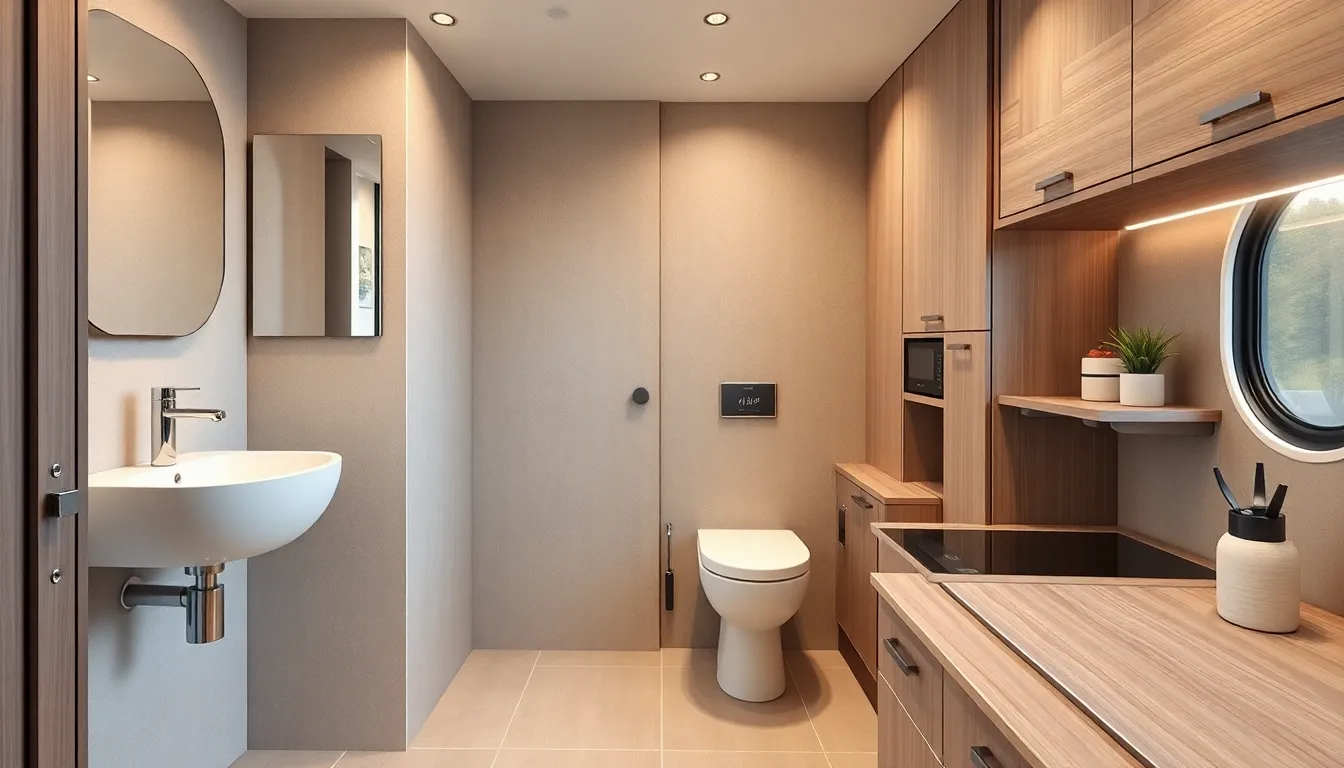
Maximizing every square inch becomes crucial when we’re designing combined bathroom kitchen spaces that serve multiple functions without compromising on style or efficiency.
Wall-Mounted Sinks and Toilets
Wall-mounted sinks create significantly more floor space in compact bathroom areas while adding a sleek modern aesthetic that complements contemporary kitchen designs. These floating fixtures eliminate bulky pedestals and allow for easier cleaning underneath, making small spaces feel more open and airy.
Wall-mounted toilets offer similar space-saving benefits by providing additional floor area and creating a streamlined appearance that enhances the visual flow between bathroom and kitchen zones. Installing these fixtures requires proper wall reinforcement but results in a more spacious feeling environment.
Combined installation of both wall-mounted sinks and toilets maximizes the impact of space-saving design while maintaining consistent visual lines that connect seamlessly with adjacent kitchen cabinetry.
Compact Appliance Selection
Compact appliances like smaller refrigerators, microwaves, and dishwashers fit perfectly into tight bathroom kitchen combinations without sacrificing essential functionality. These space-conscious options typically measure 18-24 inches wide compared to standard 30-36 inch models.
Tabletop appliances including toaster ovens and slow cookers provide cooking capabilities while occupying minimal counter space that can double as bathroom vanity surfaces when needed. We recommend selecting appliances with similar finishes to maintain design continuity between areas.
Multi-purpose appliances such as combination microwave convection ovens or compact washer dryer units serve dual functions while occupying the footprint of single traditional appliances.
Fold-Down and Retractable Features
Fold-down tables provide additional counter space when cooking or food preparation is needed, then fold flat against the wall to maintain open pathways between bathroom and kitchen zones. These versatile surfaces can serve as breakfast bars or extra workspace as situations require.
Retractable faucets and lights tuck away when not in use, reducing visual clutter and improving the sense of openness throughout the combined space. Pull-out faucets work especially well in compact sinks that serve both kitchen prep and bathroom functions.
Sink cabinets with integrated storage keep kitchen essentials and bathroom toiletries organized while maintaining a clean, uncluttered appearance that makes small spaces feel larger and more functional.
Ventilation and Moisture Control in Combined Spaces
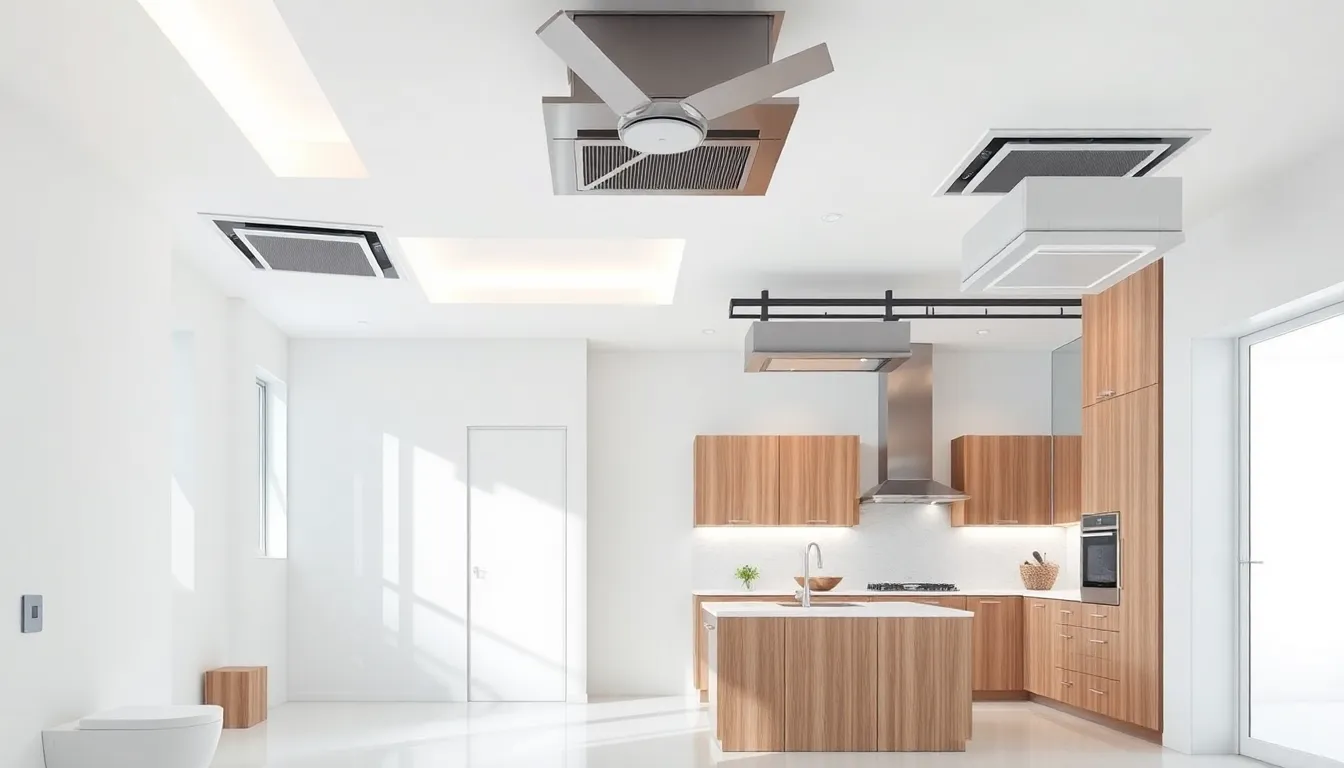
Combined bathroom and kitchen spaces require strategic ventilation planning to manage moisture levels and maintain healthy indoor air quality.
Proper Exhaust Fan Placement
Bathroom exhaust fans need continuous operation at a minimum of 25 CFM to maintain proper background ventilation. We recommend installing fans that don’t terminate into the attic, as this practice can lead to moisture problems in your home’s structure. Sealed ductwork prevents air leakage and ensures your exhaust system operates at peak efficiency.
Kitchen exhaust placement requires more careful consideration due to cooking activities and heat generation. Position exhaust grills at least 6 feet away from cooktops to prevent grease buildup on the fan components. Install washable filters in kitchen exhaust systems to maintain proper airflow and reduce maintenance requirements. Kitchen spaces need continuous exhaust at 35 CFM to effectively remove cooking odors and moisture.
Humidity Management Answers
Energy Recovery Ventilators (ERVs) provide the most effective humidity control for combined spaces by recovering energy from exhaust air while supplying fresh outdoor air. These systems maintain comfortable humidity levels year round without dramatically increasing energy costs. ERV units work particularly well in tight construction where natural air exchange is limited.
Balanced air systems coordinate exhaust and supply ventilation to prevent pressure imbalances that can affect both spaces. We suggest installing humidity sensors that automatically adjust ventilation rates based on moisture levels in the combined area. Smart humidity controls can detect when cooking or bathing activities increase moisture levels and respond accordingly.
Air Circulation Improvement Methods
Continuous ventilation systems outperform intermittent ventilation for contaminant control while requiring lower airflow rates than on demand systems. Continuous operation ensures consistent air quality and prevents moisture buildup during periods of low activity. These systems maintain steady air exchange rates that prevent stagnant air pockets in corners and dead zones.
Makeup air provisions become essential in tight construction to prevent depressurization that can affect both kitchen and bathroom ventilation performance. Install makeup air systems that provide tempered fresh air to replace exhausted air and maintain proper system balance. Cross ventilation between the combined spaces helps distribute conditioned air more effectively and reduces the load on mechanical systems.
Privacy Solutions for Open Bathroom Kitchen Layouts
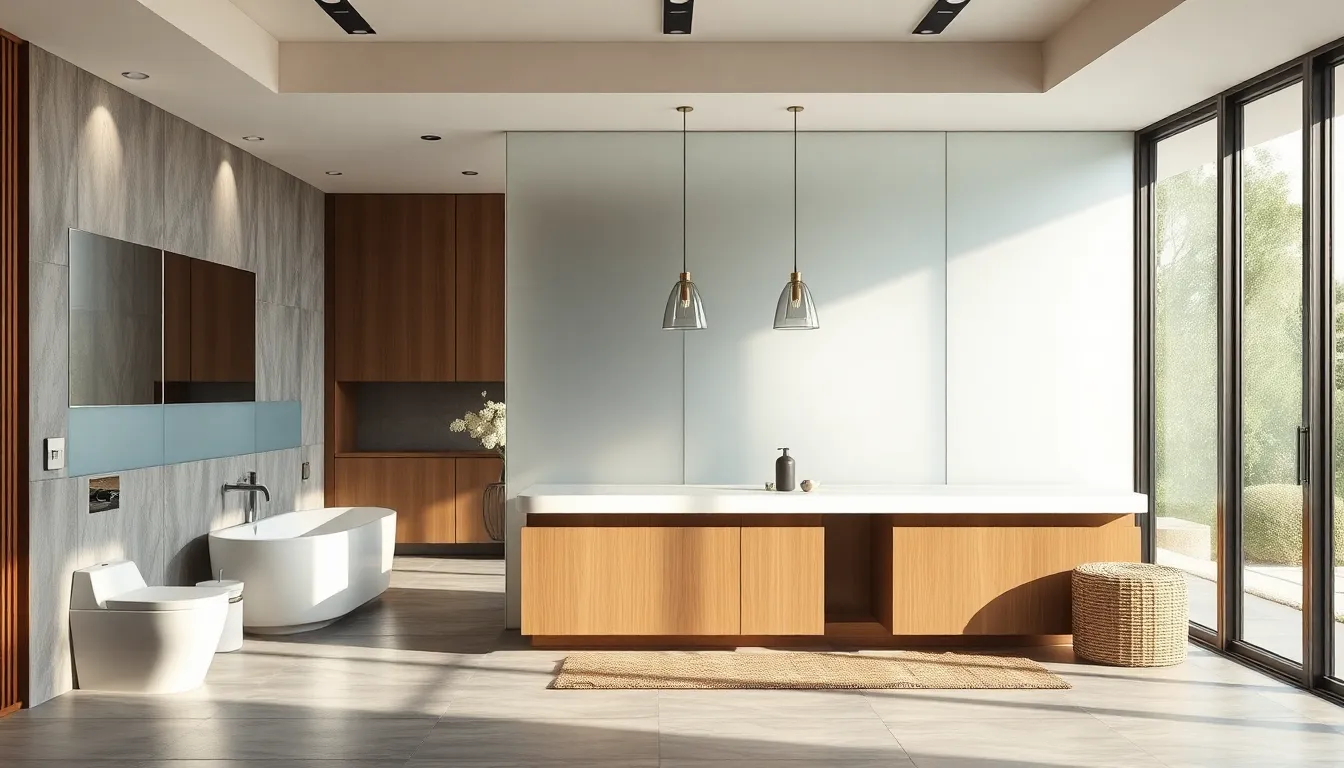
Open bathroom kitchen layouts require thoughtful privacy answers to maintain comfort and functionality. We’ll explore effective strategies that preserve the open concept while creating discrete zones for different activities.
Strategic Room Dividers and Screens
Dividing spaces becomes essential when creating private zones within open layouts. Room dividers offer flexible answers that separate bathroom and kitchen activities without permanent structural changes. These versatile elements can range from freestanding panels to sliding track systems that adapt to your daily needs.
Flexible screens provide temporary privacy barriers while maintaining airflow throughout the space. Fabric screens add warmth and texture to the design while offering adjustable coverage for different activities. Metal screens bring industrial elegance and can incorporate decorative patterns that complement your overall aesthetic. We recommend choosing screens with easy mobility features so you can reconfigure your privacy zones as needed.
Positioning dividers strategically allows you to create private pockets without blocking natural light flow. Consider placing dividers at angles that provide maximum coverage while maintaining visual connection to other areas. Multi panel systems work particularly well for creating graduated privacy levels.
Frosted Glass and Translucent Materials
Frosted glass panels deliver sophisticated privacy answers that define spaces like toilet areas or shower zones. These panels reduce visibility while allowing natural light to pass through, maintaining the bright, airy feel of open layouts. We find that frosted glass works exceptionally well for creating private zones without sacrificing the spacious atmosphere.
Translucent materials extend beyond traditional glass to include acrylic panels, rice paper screens, and fabric installations. These materials add privacy layers without completely blocking light flow between areas. Translucent walls can be customized with various opacity levels to match your exact privacy needs.
Installing glass partitions creates permanent privacy zones that still feel connected to the broader space. Floor to ceiling installations provide maximum privacy while maintaining light transmission. Half height panels offer partial privacy while preserving the open concept feel.
Sound Dampening Techniques
Absorptive tiles significantly reduce echo and noise levels in bathroom areas within open layouts. Sound absorbing materials help contain toilet and shower sounds, creating more comfortable environments for both cooking and bathing activities. We recommend installing these tiles strategically in areas where sound reflection is most problematic.
Acoustic panels minimize sound travel between different zones of your combined space. These panels can be incorporated into wall designs or ceiling installations to create quieter environments. Strategic placement of acoustic materials helps maintain conversation privacy while cooking or using bathroom facilities.
Sound barriers work alongside absorptive materials to create comprehensive noise control systems. Soft furnishings like rugs and curtains provide additional sound dampening while contributing to the overall design aesthetic. Dense materials positioned between zones help contain sounds within exact areas.
Budget-Friendly Renovation Tips for Dual Spaces
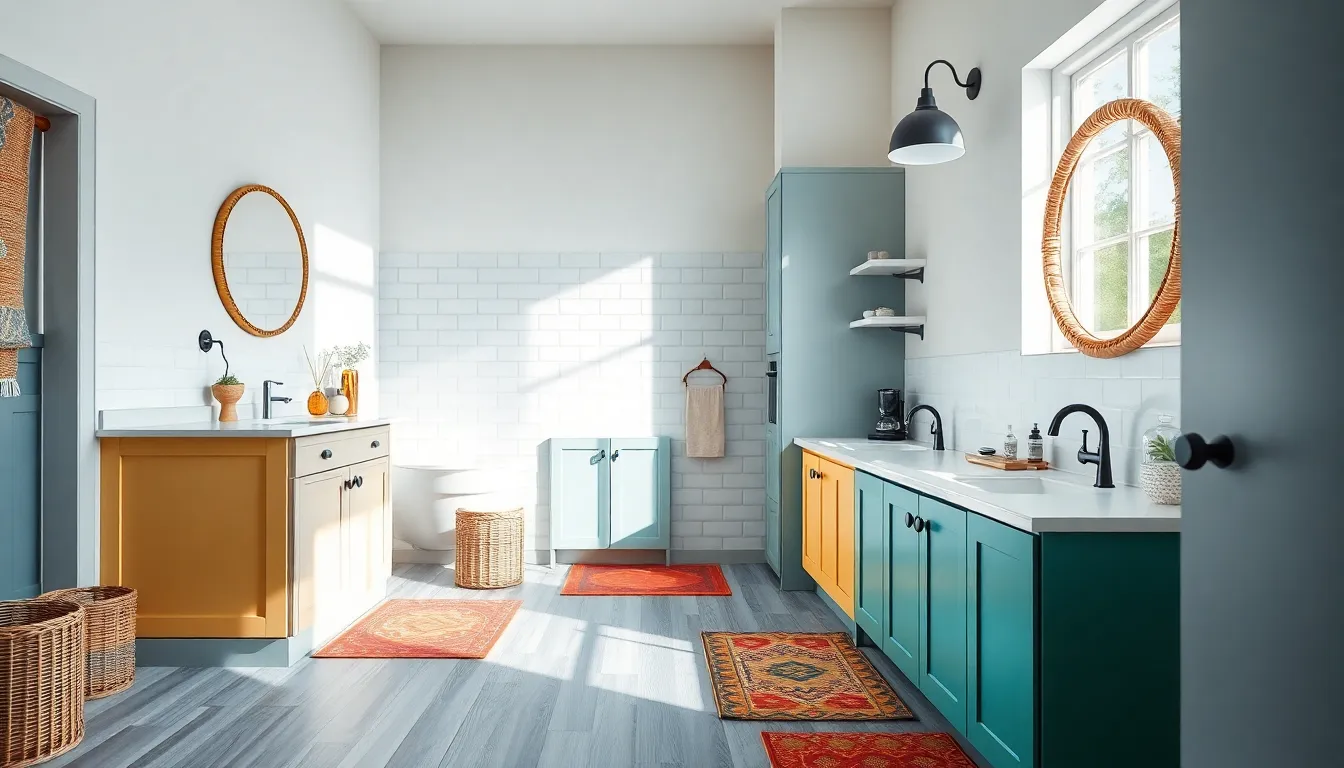
Creating functional bathroom kitchen combinations doesn’t require very costly when we approach renovations strategically. Smart planning and prioritization allow us to achieve high-impact results while controlling costs effectively.
DIY Projects That Make a Big Impact
Painting projects deliver dramatic transformations without major expense in both bathroom and kitchen areas. We can paint contrasting cabinet colors to create visual interest and define separate zones within our dual space design. Wall stencils provide an affordable alternative to expensive wallpaper while adding personality to both cooking and bathing areas.
Cabinet door updates offer another cost-effective way to refresh our space instantly. Swapping out old doors for modern styles or adding vintage-inspired elements creates a cohesive look between kitchen and bathroom cabinetry. Colorful kitchen rugs and bath mats help tie the spaces together while adding comfort underfoot.
Mirror replacements make bathrooms appear larger and more updated without expensive renovations. Installing new light fixtures brightens both areas and creates better task lighting for cooking and grooming activities. Woven rattan frames around mirrors add texture and warmth to complement kitchen design elements.
Hardware replacement represents one of the easiest and most affordable updates we can make. Matching cabinet pulls, faucet handles, and towel bars throughout both spaces creates visual continuity. Chrome, brushed nickel, or matte black finishes work well across kitchen and bathroom applications.
Cost-Effective Material Alternatives
Laminate flooring provides an affordable alternative to expensive tile while offering water resistance suitable for both bathroom and kitchen areas. Vinyl plank flooring mimics hardwood or stone appearances at a fraction of the cost and handles moisture better than traditional materials.
Ready-to-assemble cabinets cost significantly less than custom options while still providing quality storage answers. We can choose matching styles for both spaces or select complementary designs that create visual flow between areas. Stock cabinets often come in standard sizes that work well in most bathroom kitchen combinations.
Peel-and-stick backsplash tiles eliminate the need for professional installation while providing stylish protection behind sinks and stoves. These removable options allow us to experiment with patterns and colors without permanent commitment. Budget-friendly paint transforms both wall and cabinet surfaces for minimal investment.
Countertop alternatives like butcher block, concrete, or laminate offer style and durability at lower price points than granite or quartz. Ready-made vanity tops with attached sinks provide instant updates for bathroom areas while maintaining consistency with kitchen counter materials.
Phased Renovation Planning
Starting with high-impact, low-cost upgrades helps us see immediate results while spreading renovation costs over time. We should prioritize cabinet painting and hardware replacement before moving to larger projects like flooring or fixture installation. Urgent repairs and safety issues always come first in our renovation timeline.
Shopping for deals and clearance items allows us to purchase quality materials at reduced prices. Discontinued products, surplus finds, and seasonal sales provide opportunities to save money on countertops, sinks, and tiles. Home improvement stores often discount display models and overstock items.
Reusing existing fixtures in good condition helps control costs while maintaining functionality. Refurbishing vintage elements preserves character while avoiding replacement expenses. We can update old fixtures with new hardware or paint to match our design scheme.
Avoiding complete replacements keeps projects manageable and prevents overspending on unnecessary items. Focusing on what makes the most visual impact for the least money ensures our renovation budget goes further. Gradual improvements allow us to live comfortably in our space while working toward our design goals.
Conclusion
Creating successful bathroom-kitchen combinations requires thoughtful planning and strategic design choices that we’ve explored throughout this guide. From shared plumbing answers to innovative storage systems these spaces can transform how we live in compact homes.
We’ve shown that achieving both functionality and style doesn’t require massive budgets or complex renovations. Smart fixture placement proper ventilation and creative privacy answers make these dual-purpose spaces both practical and beautiful.
Whether you’re designing a tiny home studio apartment or simply maximizing your current space these bathroom-kitchen ideas offer endless possibilities. With the right approach we can create seamless multi-functional environments that enhance our daily routines while maximizing every square foot.
Frequently Asked Questions
What are the main benefits of combining bathroom and kitchen design elements?
Combining bathroom and kitchen elements maximizes space efficiency, particularly in small homes and apartments. This approach creates multi-functional areas that maintain both style and comfort while reducing construction costs through shared utilities. The design strategy is especially valuable for studio apartments, tiny homes, and modern minimalist living spaces.
How can I maintain privacy in an open bathroom-kitchen layout?
Use flexible room dividers, frosted glass partitions, or translucent materials that allow light flow while creating discrete zones. Strategic placement of fixtures can create natural privacy barriers. Sound dampening techniques like acoustic panels and absorptive tiles help minimize noise between areas while preserving the open concept design.
What are the best space-saving fixtures for combined bathroom-kitchen areas?
Wall-mounted sinks and toilets create more floor space and a modern aesthetic. Compact appliances, multi-purpose fixtures like vanity countertops extending into breakfast bars, and fold-down tables maximize functionality. Vertical storage solutions including floor-to-ceiling cabinets and corner units with rotating shelves optimize space utilization.
How do shared plumbing solutions work in bathroom-kitchen combinations?
Back-to-back layouts allow kitchen and bathroom sinks to share water lines, reducing plumbing materials and installation costs. Central utility cores concentrate plumbing components into designated zones, enhancing efficiency. Stacked designs in multi-story homes align fixtures vertically, simplifying waste line routing and decreasing installation complexity.
What ventilation considerations are important for combined spaces?
Proper exhaust fan placement and continuous operation manage moisture levels and maintain healthy indoor air quality. Energy Recovery Ventilators (ERVs) provide effective humidity control, while balanced air systems prevent pressure imbalances. Strategic ventilation planning includes makeup air provisions to maintain proper system balance and contaminant control.
How can I create visual harmony between bathroom and kitchen areas?
Use consistent flooring materials and coordinated color schemes, preferably neutral palettes for visual continuity. Match cabinet finishes, hardware styles, and fixture proportions across both spaces. Implement layered lighting strategies that meet each area’s unique needs while maintaining a cohesive aesthetic throughout the combined space.
What are some budget-friendly renovation tips for dual spaces?
Focus on high-impact DIY projects like painting cabinets and updating hardware. Choose cost-effective materials such as laminate flooring and ready-to-assemble cabinets. Plan renovations in phases, starting with visible upgrades and gradually addressing larger projects. Reuse existing fixtures where possible to control costs while maintaining functionality.
How do I maximize storage in combined bathroom-kitchen spaces?
Install built-in cabinetry with adjustable shelving that accommodates both kitchenware and toiletries. Use hidden storage solutions like under-sink pull-out baskets and wall niches. Implement vertical storage techniques including tall cabinets, ladder shelves, and floating shelves to maximize space without sacrificing floor area.

